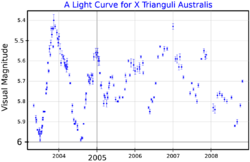Astronomy:X Trianguli Australis
 A visual band light curve for X Trianguli Australis, plotted from data published by Tabur et al. (2009)[1] | |
| Observation data Equinox J2000.0]] (ICRS) | |
|---|---|
| Constellation | Triangulum Australe |
| Right ascension | 15h 14m 19.17448s[2] |
| Declination | −70° 04′ 46.1266″[2] |
| Apparent magnitude (V) | +5.75[3] |
| Characteristics | |
| Spectral type | C5.5[4] |
| B−V color index | 3.271±0.019[3] |
| Variable type | Lb[5] |
| Astrometry | |
| Radial velocity (Rv) | −3.2±1.5[6] km/s |
| Proper motion (μ) | RA: +4.276[2] mas/yr Dec.: −7.566[2] mas/yr |
| Parallax (π) | 3.5388 ± 0.1944[2] mas |
| Distance | 920 ± 50 ly (280 ± 20 pc) |
| Absolute magnitude (MV) | −1.97[3] |
| Details | |
| Mass | 4.1[7] M☉ |
| Radius | 257[7] R☉ |
| Luminosity (bolometric) | 8,599[8] L☉ |
| Temperature | 2,860±350[8] K |
| Other designations | |
| Database references | |
| SIMBAD | data |
X Trianguli Australis is a star in the southern constellation Triangulum Australe. It is a red-hued carbon star approximately 920 light years (280 parsecs) from Earth, though this could vary by up to 200 light years.[10] It is a semi-regular variable star with two periods of around 385 and 455 days, and is of spectral type C5.5(Nb).[1] It ranges from magnitudes 5.03 to 6.05.[11] Its designation is from the variable star designation developed by German astronomer Friedrich Wilhelm Argelander.
It is a cool star, with estimates of its surface temperature ranging from 2,200 to 2,700 Kelvin.[10] A giant star, its diameter is 400 times that of the sun, and if placed at the center of the Solar System would stretch out to 30% further than Mars' orbit. Its absolute magnitude is −2.0.[10]
References
- ↑ Jump up to: 1.0 1.1 Tabur, V.; Bedding, T. R. (2009). "Long-term Photometry and Periods for 261 Nearby Pulsating M Giants". Monthly Notices of the Royal Astronomical Society 400 (4): 1945–61. doi:10.1111/j.1365-2966.2009.15588.x. Bibcode: 2009MNRAS.400.1945T.
- ↑ Jump up to: 2.0 2.1 2.2 2.3 2.4 Brown, A. G. A. (August 2018). "Gaia Data Release 2: Summary of the contents and survey properties". Astronomy & Astrophysics 616: A1. doi:10.1051/0004-6361/201833051. Bibcode: 2018A&A...616A...1G.
- ↑ Jump up to: 3.0 3.1 3.2 Anderson, E.; Francis, Ch. (2012). "XHIP: An extended hipparcos compilation". Astronomy Letters 38 (5): 331. doi:10.1134/S1063773712050015. Bibcode: 2012AstL...38..331A.
- ↑ Warner, B. (1963). "Spectral classification of some Southern late-type peculiar stars". Monthly Notices of the Royal Astronomical Society 126: 61. doi:10.1093/mnras/126.1.61. Bibcode: 1963MNRAS.126...61W.
- ↑ Samus', N. N; Kazarovets, E. V; Durlevich, O. V; Kireeva, N. N; Pastukhova, E. N (2017). "General catalogue of variable stars: Version GCVS 5.1". Astronomy Reports 61 (1): 80. doi:10.1134/S1063772917010085. Bibcode: 2017ARep...61...80S.
- ↑ Gontcharov, G. A. (November 2006), "Pulkovo Compilation of Radial Velocities for 35495 Hipparcos stars in a common system", Astronomy Letters 32 (11): 759–771, doi:10.1134/S1063773706110065, Bibcode: 2006AstL...32..759G.
- ↑ Jump up to: 7.0 7.1 Kervella, Pierre; Arenou, Frédéric; Thévenin, Frédéric (2022). "Stellar and substellar companions from Gaia EDR3". Astronomy & Astrophysics 657: A7. doi:10.1051/0004-6361/202142146. Bibcode: 2022A&A...657A...7K.
- ↑ Jump up to: 8.0 8.1 Rau, G. et al. (April 2017). "The adventure of carbon stars. Observations and modeling of a set of C-rich AGB stars". Astronomy & Astrophysics 600: 21. doi:10.1051/0004-6361/201629337. A92. Bibcode: 2017A&A...600A..92R.
- ↑ "V* X TrA". SIMBAD. Centre de données astronomiques de Strasbourg. http://simbad.u-strasbg.fr/simbad/sim-basic?Ident=V%2A+X+TrA.
- ↑ Jump up to: 10.0 10.1 10.2 Kaler, Jim (19 October 2012). "X Trianguli Australis". Stars. University of Illinois. http://stars.astro.illinois.edu/sow/xtra.html.
- ↑ "X TrA". International Variable Star Index. American Association of Variable Star Observers. 11 November 2011. http://www.aavso.org/vsx/index.php?view=detail.top&oid=36671.
 |

